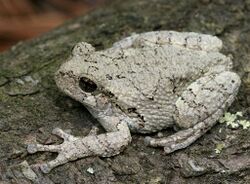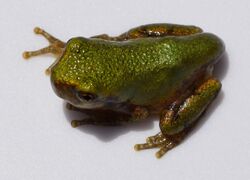Biology:Cope's gray treefrog
| Cope's gray treefrog | |
|---|---|

| |
| File:Hyla chrysoscelis call.ogg | |
| Scientific classification | |
| Kingdom: | Animalia |
| Phylum: | Chordata |
| Class: | Amphibia |
| Order: | Anura |
| Family: | Hylidae |
| Genus: | Dryophytes |
| Species: | D. chrysoscelis
|
| Binomial name | |
| Dryophytes chrysoscelis (Cope, 1880)
| |
| Synonyms | |
| |
Cope's gray treefrog[2] (Dryophytes chrysoscelis) is a species of treefrog found in the United States and Canada. It is almost indistinguishable from the gray treefrog (Dryophytes versicolor), and shares much of its geographic range. Both species are variable in color, mottled gray to gray-green, resembling the bark of trees. These are treefrogs of woodland habitats, though they will sometimes travel into more open areas to reach a breeding pond. The only readily noticeable difference between the two species is the mating call — Cope's has a faster-paced and slightly higher-pitched call than D. versicolor. In addition, D. chrysoscelis is reported to be slightly smaller, more arboreal, and more tolerant of dry conditions than D. versicolor.[3]
Taxonomy
Edward Drinker Cope described the species in 1880. The specific name, chrysoscelis, is from Greek chrysos, gold, and scelis, leg.[4]
Microscopic inspection of the chromosomes of D. chrysoscelis and D. versicolor reveals differences in chromosome number. D. chrysoscelis is diploid, having two complete sets of chromosomes, the usual condition in vertebrates. D. versicolor is tetraploid, having double the usual number of chromosomes. Generally, D. versicolor is believed to have evolved from D. chrysoscelis in the last major ice age, when areas of extremely low temperatures divided populations. Despite currently sharing habitat, the two species generally do not interbreed.
D. chrysoscelis is known to be largely intersterile with D. versicolor but there may be a limited amount of interfertility in sympatry. To enforce speciation there may be unknown mechanisms of reinforcement deployed between these species and further research may be fruitful.[5]
Description

Both D. chrysoscelis and D. versicolor have black-marked bright orange to yellow patches on their hind legs, which distinguishes them from other treefrogs, such as D. avivoca.[3] The bright-yellow pattern is normally hidden, but exposed when the frog leaps. This "flash pattern" likely serves to startle a predator as the frog makes its escape.[6] The pattern and color variations of skin for this species will change depending on the environment they are found in.[7] Similar hidden bright patterns are common in various Lepidoptera, for instance moths of the genus Catocala.[8] Both species of gray treefrogs are slightly sexually dimorphic. Males have black or gray throats in the breeding season, while the throats of the females are lighter.[9] Usually, the younger frogs in this species will often be seen more with the greenish color throughout the breeding seasons. As they age they will lose the greenish color and move towards the distinct gray color. [10]

Skin secretions from this species may be irritating or toxic to mouth, eyes, other mucous membranes.[11]
Distribution and habitat
The range of D. chrysoscelis is more southerly; it is apparently the species found in the lower elevation Piedmont and Coastal Plain of Virginia and the Carolinas. In those areas, D. versicolor may be present only in the Appalachians.[3] While this species is most abundant in the southeast, it can be found as far north as Manitoba. D. chrysoscelis has also been observed to practice freeze tolerance in a lab setting, which could help it survive in cold climates.[12] These frogs are one of the very few that can mobilize glycerol as a cryoprotectant. Glycerol production is low when the temperature is warmer, but when it gets colder, the glycerol in the body is rapidly produced.[13] When studying ice concentration of overwintering frogs, 40-50% of total body water was frozen.[14] They prefer to perch on pipes located along the edges of wetlands and close to trees, which suggests that the terrestrial habitat surrounding wetlands is an important component of the species habitat.[15] The bird-voiced treefrog, D. avivoca, is similar to D. chrysoscelis and D. versicolor, but is smaller (25–50 mm in length vs 32–62 mm for the gray treefrog).
Behavior

File:Hyla chrysoscelis call video.webm In the Southeastern United States, Cope's gray treefrog breeds and calls from May to August. Isolated males start calling from woodland areas during warm weather a week or more before migrating to temporary ponds to breed. There they form aggregations (choruses) and call together. Chorusing is most frequent at night, but individuals often call during daytime in response to thunder or other loud noises. These individual calls are produced at high sound pressure levels (SPLs) reaching 85 to 90 dB and sustained noise levels in choruses commonly range between 70 and 80 dB SPL.[16] Female treefrogs have been found to be able to differentiate calls at scales of up to a few decibels.[17] Eggs are laid in batches of 10 to 40 on the surfaces of shallow ponds and other small bodies of water. These temporary bodies of water usually lack fish, and females preferentially lay their eggs in water bodies that lack fish or other predatory vertebrates and have lower desiccation risk.[18][19][20] Eggs hatch in about five days and metamorphosis takes place at about 45–65 days.[3][9][21]
The diet of Cope's gray treefrog primarily consists of insects such as moths, mites, spiders, plant lice, and harvestmen. Snails have also been observed as a food source. Like most frogs, Dryophytes chrysocelis is an opportunistic feeder and may also eat smaller frogs, including other treefrogs.[22] Once the breeding season is over, Cope's gray treefrogs will forage continuously until winter.[23]
Dryophytes chrysoscelis is capable of surviving temperatures as low as –8 °C.[24]
References
- ↑ IUCN SSC Amphibian Specialist Group (2022). "Dryophytes chrysoscelis". IUCN Red List of Threatened Species 2022: e.T55448A196334128. doi:10.2305/IUCN.UK.2022-1.RLTS.T55448A196334128.en. https://www.iucnredlist.org/species/55448/196334128. Retrieved 2 December 2022.
- ↑ Hyla chrysoscelis, Amphibian Species of the World 5.6
- ↑ 3.0 3.1 3.2 3.3 Martof, B. S., et al. (1980). Amphibians and Reptiles of the Carolinas and Virginia. Chapel Hill: University of North Carolina Press. ISBN 0-8078-4252-4.
- ↑ Family Group Names in Diptera
- ↑ Noor, Mohamed A F (1999). "Reinforcement and other consequences of sympatry". Heredity (The Genetics Society (Nature)) 83 (5): 503–508. doi:10.1038/sj.hdy.6886320. ISSN 0018-067X. PMID 10620021.
- ↑ Tesler, P. Exploratorium The Amazing, Adaptable Frog. The Exploratorium. San Francisco.
- ↑ Bogart, James P.; Jaslow, Alan P. (1979). Distribution and call parameters of Hyla chrysoscelis and Hyla versicolor in Michigan. Toronto: Royal Ontario Museum. ISBN 0-88854-229-1. http://dx.doi.org/10.5962/bhl.title.52057.
- ↑ Sargent. (1969). A suggestion regarding hindwing diversity among moths of the genus Catocala OF (Noctuidae). Journal of the Lepidopterists' Society 23: 261-264.
- ↑ 9.0 9.1 Tyning, T. F. (1990). A Guide to Amphibians and Reptiles. Boston: Little, Brown and Company. ISBN 0-316-81719-8.
- ↑ Roseman, Kimberly (2017). "The Utility of Hyla squirrella Microsatellite DNA Markers for Population Genetic Studies of Hyla versicolor and Hyla chrysoscelis". Western Illinois University ProQuest Dissertations. https://www.proquest.com/docview/1933027058.
- ↑ "Species profile: Cope's Gray Treefrog (Hyla chrysoscelis)". http://srelherp.uga.edu/anurans/hylchr.htm.
- ↑ Costanzo, Jon (May 1, 1992). "Freeze Tolerance as an Overwintering Adaptation in Cope's Grey Treefrog (Hyla chrysoscelis)". Copeia 1992 (2). doi:10.2307/1446222.
- ↑ Amarl M. C. F. 2018
- ↑ Costanzo, Jon P.; Wright, Michael F.; Lee, Richard E. (1992). "Freeze Tolerance as an Overwintering Adaptation in Cope's Grey Treefrog (Hyla chrysoscelis)". Copeia 1992 (2): 565–569. doi:10.2307/1446222. ISSN 0045-8511. https://www.jstor.org/stable/1446222.
- ↑ Pittman; Jendrek, A.L; Price, S.; Dorcas, M.E (2008). "Habitat Selection and Site Fidelity of Cope's Gray Treefrog (Hyla chrysoscelis) at the Aquatic-Terrestrial Ecotone.". Journal of Herpetology 42 (2): 378–385. doi:10.1670/07-1702.1.
- ↑ Lee, N., Ward, J. L., Vélez, A., Micheyl, C., & Bee, M. A. (2017). Frogs exploit statistical regularities in noisy acoustic scenes to solve cocktail-party-like problems. Current Biology, 27(5), 743–750. https://doi.org/10.1016/j.cub.2017.01.031
- ↑ Bee, Mark A.; Vélez, Alejandro; Forester, James D. (2012-05-01). "Sound level discrimination by gray treefrogs in the presence and absence of chorus-shaped noise". The Journal of the Acoustical Society of America 131 (5): 4188–4195. doi:10.1121/1.3699271. ISSN 0001-4966. PMID 22559390. Bibcode: 2012ASAJ..131.4188B.
- ↑ Resetarits, Jr., William J. (1989). "Choice of oviposition site by Hyla chrysoscelis: role of predators and competitors". Ecology 70 (1): 220–228. doi:10.2307/1938428. https://www.researchgate.net/publication/245657502.
- ↑ Pintar, Matthew R.; Resetarits, Jr., William J. (2017). "Out with the old, in with the new: oviposition preference matches larval success in Cope's gray treefrog, Hyla chrysoscelis". Journal of Herpetology 51 (2): 186–189. doi:10.1670/16-019. http://www.matthewpintar.net/uploads/2/9/8/5/29857083/pintar___resetarits_2017_jherp.pdf.
- ↑ Pintar, Matthew R.; Resetarits, Jr., William J. (2017). "Relative predation risk and risk of desiccation co-determine oviposition preferences in Cope's gray treefrog, Hyla chrysoscelis". Oecologia 184 (2): 423–430. doi:10.1007/s00442-017-3875-7. PMID 28470466. Bibcode: 2017Oecol.184..423P. https://www.researchgate.net/publication/316689673.
- ↑ Rubio, M. Atlanta's Backyard Herps. Accessed 2 June 2013.
- ↑ Conant, Roger (1975). A field guide to reptiles and amphibians of Eastern and Central North America. Isabelle Hunt Conant ([2d ed.] ed.). Boston: Houghton Mifflin. ISBN 0-395-19979-4. OCLC 1423604. https://www.worldcat.org/oclc/1423604.
- ↑ Ritke, M. E., Babb, J. G., & Ritke, M. K. (1992). Temporal patterns of reproductive activity in the gray treefrog (Hyla chrysoscelis). Journal of Herpetology, 26(1), 107-111.
- ↑ Adaptations of Frogs to Survive Freezing
Further reading
- Mary Hoff (March–April 2014). "Chirp, Croak, Snore". DNR (Minnesota Conservation Volunteer): 32.
External links
| Wikimedia Commons has media related to Hyla chrysoscelis. |
- Hyla chrysoscelis. Amphibiaweb. Accessed 2 June 2013.
- Hyla chrysoscelis. NatureServe. Accessed 2 June 2013.
Wikidata ☰ Q1058790 entry
 |
- ↑ do Amaral, M. C. F., Frisbie, J., Goldstein, D. L., & Krane, C. M. (2018). The cryoprotectant system of Cope’s gray treefrog, Dryophytes chrysoscelis: responses to cold acclimation, freezing, and thawing. Journal of Comparative Physiology. B, Biochemical, Systemic, and Environmental Physiology, 188(4), 611–621. https://doi.org/10.1007/s00360-018-1153-6

